| | |
Warning: This infobox has missing parameters: subgroup, type and unrecognized parameters: era, members, imageBG
- "… You are part of the greatest navy ever assembled. The might of the Empire rests on the military — and the Imperial Navy embodies the most elite and trusted segment of that power. Only the best, the most disciplined, are admitted to our ranks. We who serve the Emperor in the Imperial Navy have made this Empire the irresistible, galaxy-spanning force it is today."
- ―Fleet Admiral Holt, cadet indoctrination speech excerpt
The Imperial Navy, also known as the Imperial Starfleet, Imperial Fleet, Imperial Battlefleet, Imperial Space Navy, or Imperial Space Service, was the naval branch of the Imperial Military of the Galactic Empire. At its peak, it fielded millions of warships, logistics vessels and fighters, maintaining Imperial control throughout the galaxy.
The Imperial Navy was formed from the Republic Navy of the Galactic Republic in 19 BBY, as part of Palpatine's Imperialization campaign during the rise of the Empire.[1] A reorganized command structure, eventually consisting of twelve Grand Admirals,[2] oversaw the rapid expansion of the fleet that had begun during the Clone Wars. Growing discontent with the Empire eventually coalesced into the Alliance to Restore the Republic, which began a military campaign against Imperial forces, that became known as the Galactic Civil War.
After the Battle of Endor in 4 ABY, the Empire began to devolve into warlordism and infighting, splintering the Imperial Navy. It would not again become a cohesive unit until the establishment of the Imperial Remnant under Grand Admiral Gilad Pellaeon, becoming a veritable fighting force once again under his command during the Yuuzhan Vong War. The Imperial Navy would regain much of its former strength by the time of the Fel Empire, under which it fought the Galactic Alliance in the Sith–Imperial War. The Navy would be split into those loyal to Roan Fel and those who served Darth Krayt's Galactic Empire in the subsequent civil war.[3]
The Imperial Navy was one of the most formidable militaries ever assembled, consisting of millions of warships, fighters and transports, manned by trillions of fleet crew.[4] The mainstays of its fleets - the Star Destroyer and Super Star Destroyer capital ships[5] and the TIE fighter series of starfighters - became some of the most visible symbols of Imperial rule to the galaxy's civilian populace.[6]
Role
- "The Empire, on the other hand, maintains massive fleets containing up to two dozen capital ships - few would dare to challenge such a formidable force. These vessels boast heavy armor plating, high-powered shielding, and an enormous amount of firepower, making them capable of reducing an entire planet to nothing more than charred remains. Truly these are the most awesome weapons of war ever constructed…"
- ―Commander Elpfel, commanding officer of the Mon Calamari cruiser Wavesong.
Specific responsibilities of the Imperial Navy included defending Imperial citizens from space-based threats such as pirates, smugglers, and other armed governments, enforcing Imperial will, and overseeing commerce through customs and blockade operations. The Imperial Navy also performed orbital bombardments, transported major ground force deployments, and supported them with space and aerial support.
The Imperial Navy was formed from the Republic Navy, and as such was still under Naval Command. The Imperial Navy conducted itself by the Imperial Naval Code, a set of martial laws and regulations created to guide the massive military organization. Under the Non-huMan rule, the vast majority of personnel in the Imperial Starfleet were male Humans, although some Human females, such as Admiral Daala, and even other species were also in the service, such as the Chiss Grand Admiral Thrawn.
History
The New Order
The Imperial Navy inherits the Republic's Star Destroyers.
The Imperial Navy was formed from the Republic Navy of the Old Republic. After Supreme Chancellor Palpatine declared himself Emperor in 19 BBY, establishing the first Galactic Empire, he began a campaign of Imperialization, under which the Republic Navy, now containing the individual member world's home fleets,[7] was renamed the Imperial Navy. Palpatine's first purge of the Imperial Navy occurred within two weeks into the Empire's rule. A rapid expansion of the number of Naval ships begun near the end of the Clone Wars was further increased.[1] The command structure was eventually reorganized around 2 BBY, with twelve Grand Admirals leading the Navy.[2]
During the Reconquest of the Rim, starting in 19 BBY, the bulk of the Imperial fleet was still composed of Victory-class and Venator-class Star Destroyers, with their fighters being composed of V-wings and ARC-170s. However, as the pacification continued, the old Republic warships were gradually retired in favor of the Imperial-class Star Destroyers, and TIE fighers also flew among the other fighters.[8]
Galactic Civil War

The Executor, escorted by two Imperial Star Destroyers
Growing discontent with the Empire eventually coalesced into the Alliance to Restore the Republic, which began a military campaign against Imperial forces. In many subsequent engagements, the Navy provided support to the Imperial Army as well as fighting the Alliance ship-to-ship. Although the Alliance Fleet was not as large or as powerful as the well-trained Imperial Navy, the two fleets would battle each other regularly throughout the Galactic Civil War. The Navy was present at both Death Stars and suffered massive losses as a result of the Alliance's destruction of the stations.[9][10]
Not too long after the defeat at the Battle of Endor, in 4 ABY the Galactic Empire split up into warring factions led by warlords, and the Imperial Navy splintered along with it. While much of the remnants of the Imperial Navy were later reunited under impressive Imperial commanders, the military organization ceased to be reunited as a whole after the death of Emperor Palpatine. It would not again become a cohesive unit until the establishment of the Imperial Remnant under Grand Admiral Gilad Pellaeon. By the end of the Galactic Civil War, a navy that numbered in the millions was reduced to mere thousands with just two-hundred Star Destroyers remaining. It would take more than a century before the Imperial Navy restored itself to its former glory.[3]
Legacy
It would once again became a veritable fighting force participating under Pellaeon´s command in the Yuuzhan Vong War. The Imperial Navy would regain much of its former strength by the time of the Fel Empire, under which it fought the Galactic Alliance in the Sith–Imperial War, and later be split between followers of Darth Krayt's Galactic Empire and loyalists of the Empire-in-exile in the subsequent civil war.[3]
Key ships of the fleet
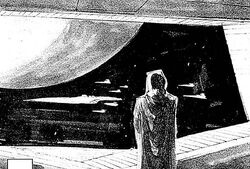
A COMPNOR member on a public relations trip observes a naval maneuver.
The most recognizable symbol of the Imperial Starfleet was the Imperial-class Star Destroyer, which peaked at over twenty-five thousand vessels,[11] although millions of starships of different designs were fielded for various purposes.
Super Star Destroyers became infamous for their size and armament, but some also contributed to the fleets as logistics vessels[12] and starfighter carriers.
Most major capital ships, battlestations and logistics vessels were constructed by Kuat Drive Yards, Loronar Corporation, and Rendili StarDrive during the height of the Galactic Empire.[13] The shipyards at Corellia supplied the Empire with gunships, corvettes and larger cruisers.[9] Additionally, countless shipyards supplied the Imperial Starfleet with support ships such as Carrack-class light cruisers, Lancer-class frigates, Strike-class cruisers, and escort carriers. In 0 BBY, it was estimated that the combined firepower of half of the starfleet was equivalent to the destructive force of of the first Death Star.[9]
Education
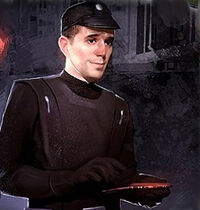
An Imperial Ensign.
- "Our credo is 'Service. Fealty. Fidelity.' This may be the first time you have heard it. By the time you graduate, it is one you will never forget."
- ―Fleet Admiral Bannidge Holt during Imperial Naval Academy cadet indoctrination speech
Candidates were accepted by Screening Officers at local recruitment centers.[14] Naval recruits first attended the Imperial Academy to gain the basis of their higher education and military discipline, and then continued their education at the Imperial Naval College, where Academy graduates received specific training on naval operations, combat, and command functions. The naval recruits also had the opportunity to participate in the Officers' Candidacy Training, if they enlisted for five years and had the necessary leadership qualities.[14] Finally, non-commissioned officers and recent graduates of the Imperial Naval College could participate in a training program through the Imperial Navy Officers' School to focus on military customs and courtesies, military history, leadership, officership, deck command exercises, discipline drills, and other pertinent areas of education of potential officers. Upon graduation, trainees were commissioned in the Imperial Navy as lieutenants.
Organization
- "You don't have an organization, admiral! What you have is nothing like the Army!"
"Yes, general, the Army has its organization. We in the Navy must content ourselves with the control of all known space." - ―An Imperial Army general and a Navy admiral.

A parade on Anaxes.
The Imperial Navy used an overall strategy of focusing on capital ship firepower rather than starfighter superiority. This was reflected through the design of their starships, the formation of their naval units and the overall organization of the force.
Ranking
Within the Imperial Navy, the various personnel held a ranking order, identifiable by Rank insignia plaques that were composed of red and blue squares. Although in theory, the plaque is associated with line rank, officers in the position of fleet admiral and ship's captain always wear the insignia of a full admiral and a senior captain/captain of the line respectively. In addition, some ranks, such as High Admiral and Admiral, can sometimes vary in the relationship between the rank itself and the position. There were two variants of the plaques: the regular version, and the specialist version. Specialist plaques usually included at least one code cylinder or, in the case of the General, had its plaque split into 4 separate plaques.
The highest positions within the Imperial Navy were Warlord and High Admiral, although they were essentially honorary and were normally held by Grand Admirals and Moffs.
The highest non-honorary title for the fleet was the Fleet Admiral, which commanded an entire fleet in the Imperial Navy. Those holding the rank of Fleet Admiral were usually the senior officers of a sector. The main practical sub-unit of the fleet, the squadron, was commanded by a flag officer, and was officially appointed as an Admiral, although those holding the rank were usually called Commander. Although officially, the rank of Systems Admiral, sometimes known as Commodore, existed as the overall commander of the Systems Force, they were in practice one and the same with squadron commanders, as most System Forces only included one squadron.
Senior Captains commanded small groups of escorts or light cruisers that weren't large enough to be a full squadron. In addition, the commanding officer of a ship always held the rank of captain. The crew of the ship also were addressed as lieutenants (or in the case of ensigns, midshipmen), regardless of their actual rank.
There were also two categories of ranks, line ranks and specialist ranks. Line ranks were held by line officers, the men who command the bridge crew, captain ships, and hoist their flags over fleets. Under line ranks, there were very few officers with permanent line ranks above the formal rank of captain of the line (and more well known as senior captain). Specialist ranks were for personnel of the Flight, Support, and Engineering branches. The ranks in the Specialist ranks section held similarities to the Imperial Army. In addition, the few specialist officers that were promoted beyond General were promoted into the line at the rank of vice admiral, although they usually retained the honorific branch titles of air marshal, war commissar, and master engineer. The junior ranks of specialist officers, captain, and below were prefixed by flight, support, or engineering depending on the branch they had served under. In the case of Flight Branch pilots, they also had their own positional titles: squadron leader, wing commander, and group captain. Generals with large base or project commands likewise received the code cylinders of a squadron or fleet commander, while TIE squadron leaders, normally flight captains, use the insignia of a ship's captain, as a fighter unit is considered the equivalent of a small-ship command.
In addition to the plaques, the Imperials also utilized code cylinders to signify their position in addition to their pragmatic use of regulating computer use aboard Imperial Navy ships, with the number used being dependent on the rank. Captains and Lieutenants generally had only one code cylinder, while the Admiral, Commodore or Commander had two, a Fleet Admiral had three and a High Admiral had four. Specialist ranking officers also utilized code cylinders, although their use was purely for decorative purposes as insignia.
Command
An individual command, a single starship, was the building block of the Imperial Starfleet. Achieving command of a starship, no matter its size, was point of pride in an officer's career. Officers commonly turned down impressive staff promotions in the hopes of receiving a ship command, although serving as a staff officer on a prominent starship, such as a squadron flagship, was often considered a fast track for promotion.
Line of battle
The most basic unit in the Imperial Navy was a line of battle, or simply a line. The Imperial Starfleet shaped four to twenty starships into lines, depending on the type of line. Commanded by a captain of the line, the line was the most amorphous level of organization in the Starfleet. The Imperial Starfleet Order of Battle outlined seven types of lines: attack, heavy attack, reconnaissance, pursuit, skirmish, troop and bombard. Attack and heavy attack lines aggressively engaged enemy starships in combat, reconnaissance lines gathered intelligence of the disposition of enemy forces, pursuit lines chased and trapped retreating enemies, and skirmish lines harassed capital starships and engaged enemy picket lines. A troop line consisted of two Evakmar-Kuat Drive Yards Corps Transport vessels, two escort vessels, and frequently two Strike-class cruisers. Its function was the deployment of Army units. A bombard (or torpedo) line typically consisted of two Torpedo Spheres.
In addition to the seven types of lines, the Imperial Navy considered an Imperial-class Star Destroyer a line in itself. While an Imperial-class Star Destroyer may have been able to act as an attack line and its complement of starfighters as a skirmish line, the decision to give commanders the option to field a heavy cruiser as a line unto itself was more political than tactical. After a naval staff study suggested a Star Destroyer was the field equivalent of the smallest of naval squadrons, the Admiralty decided that, as there were more lines than squadrons, designating the Star Destroyer as a line unit would get them more Star Destroyers. The Admiralty's thinking prevailed.
Squadron

Imperial-class Star Destroyer and TIE Fighters at the time of the Galactic Civil War.
A squadron was the smallest independent operating unit in the Imperial Navy. Composed by several lines, a squadron was commanded by an admiral and ranged from 14 to 60 ships, depending upon the composition of the lines in the squadron. A squadron was the largest concentration of ships normally assigned to a single system. The Galactic Republic designated units of identical configuration as fleets. Those units were the total naval presence in a sector. Thus, the squadron was a useful measure of the growth of the Imperial military after the establishment of Emperor Palpatine's New Order.
Similar to lines, the Imperial Navy's Order of Battle designated four types of squadrons: light, heavy, battle, and bombard. Light squadrons patrolled areas known to be safe with two attack lines, a skirmish line and a reconnaissance line. Heavy squadrons engaged planetary systems that possessed known enemy presences, with either two heavy attack lines, an attack line and a reconnaissance line for situations where the enemy's position and composition was unknown, or with three heavy attack lines and a skirmish line for situations where the enemy was known to be defending a fixed asset. It was common to assign Victory-class Star Destroyers to the latter type of heavy squadron. Battle squadrons contained an Imperial-class Star Destroyer. In addition to the Star Destroyer, there were at least three lines, two attack lines and one pursuit line, for an average of 18 ships. The mere arrival of a battle squadron, and more importantly, an Imperial-class Star Destroyer, was often enough to put down a planetary revolt or scare off an armed space-threat. Bombard squadrons subjugated worlds in open rebellion that had developed planetary defenses including multilayered planetary shields and large planetary guns with four torpedo spheres, a skirmish line, and a pursuit line.
Training Squadrons
Like other navies in the past, the Imperial Navy utilized various training squadrons, which were issued to cadets who had passed through initial pilot training. Bantha Squad and the training squadron on Victorious were a few of these training squadrons.
Notable squadrons
The Imperial Navy had several squadrons under its disposal. The 123rd Nightstalker Group, under the command of Blackhole, was comprised wholly of TIE/LN starfighters and participated in various combat operations during the Galactic Civil War. In addition, the 128th TIE Interceptor Squadron was an elite TIE//IN interceptor squadron, formerly led by Kasan Moor until her defection to the Rebel Alliance. Other TIE/IN interceptor squadrons included the 133rd Imperial Fighter Group under Xandel Carivus and the 181st Imperial Fighter Wing, later renamed the 181st Imperial Fighter Group led by Boontir Fel, which became elite under his command. The 181st Imperial Fighter Wing had several subsections, including the 2/181st and Alpha Squadron. The 37th Imperial Fighter Wing was also involved in the Battle of Saloch², where it was composed of at least 6 squadrons, including the 6/37th. Zsinj once had the 181st Imperial Fighter Group impersonated. The Black Eight Squadron was an elite TIE/LN and TIE/sa bomber squadron, of which its most notable member was Juno Eclipse, one of the leaders of the Rebel Alliance. It eventually was reorganized by 1 ABY. Avenger Squadron was another notable squadron, being composed almost entirely of TIE Avengers and was assigned to the Task Force Vengeance. Storm Squadron likewise was composed entirely of TIE Advanced X1s.
Black Squadron was a TIE fighter squadron personally commanded by Darth Vader, although most of the squadron was wiped out during the Battle of Yavin. It was well known enough that several Imperial Starfighter Squadrons derived their names from it, a notable example being Onyx Squadron.
Although technically a fleet, Death Squadron was one of the most notable squadrons, being under the direct command of Vader. It was composed of several warships, including the Executor, the first in the Executor-line of Star Dreadnoughts, which acted as its flagship. It also was composed of several other squadrons under its wing, including the 128th TIE Interceptor Squadron, the TIE/LN starfighter Obsidian Squadron, the TIE/sa bomber Scimitar Squadron.
Although not actually part of the Imperial Navy, the 501st Legion sometimes acted as a starfighter squadron for the Imperial Navy. In addition, Black Wing Squadron was also developed based on the Rebel Alliance/New Republic starfighter squadron Rogue Squadron, with the intention of having them fight it.
Because of the importance of the Death Star II's construction as well as the Battle of Endor, several squadrons had been reassigned to defend the battlestation, including Death Squadron, Scythe Squadron (which had originally been assigned to the Anoat system), Onyx Squadron (which had utilized TIE Defenders for the occasion) and the 181st Imperial Fighter Wing.
There were also some who were assigned to defend the Emperor, such as the Emperor's Sword and Emperor's Shield.
During the early years of the Galactic Empire, the 77th Air Wing was utilized during the Western Reaches Operation, which had been composed of a squadron called Sword Squadron, made up of 3 flights, Dagger Flight, Blade Flight, and Scimitar Flight. Another squadron was the 12th Squadron.
Other squadrons included the 276th Imperial TIE Bomber Group, 323rd Imperial TIE Bomber Group, Alpha Squadron, Bantha Squad, Beta Squadron, Bombard Squadron, Broadaxe Squadron, Cloak Squadron, Crimson Squadron, Delta Squadron, Dark Side Squadron, Dark Squadron, Durkii Squadron, Eagle Squadron, Ebon Squadron, Elite Squadron, Eta Squadron, Gamma Squadron, the Garqi Eagles, GoldWing Squadron, Hammer Squadron, Interloper Squadron, Iota Squadron, Mu Squadron, Nu Squadron, Raven Squadron, Reaver Squadron, Red Squadron, Red Star Squadron, Requiem Squadron, Saber Squadron, Scimitar assault wing, Shadow Squadron, the TIE Defender squadron of the same name, Shadow Wing, Shrike Squadron on Mandalore, Shrike Squadron on Saffalore, Sigma Squadron, SilverWing Squadron, Solaest Fleet Long Range Patrol Wing, Spear Squadron, Specter Squadron, Skull Squadron, Stranger Squadron, Sunspot Squadron, Talon Squadron, Tempest Squadron, Theta Squadron, the TIE/sa bomber squadron of the same name, Twilight Squadron, Veerpal Squadron, the 302nd Flight Wing, 722nd "Copperheads" and Zeta Squadron.
Some squadrons, such as Black Epsilon, were deployed for covert operations that were either too small or too sensitive for the Navy itself to get involved.
Several squadrons were also created for the Imperial Navy's successors in the Fel Empire and Krayt's Sith Empire, such as the 1st Imperial Center Core Defense Squadron, and Red Squadron.
Systems force

A typical Imperial hangar.
A systems force combined several squadrons under the command of an admiral, referred to as a commodore while leading a systems force. These combined forces were responsible for Imperial Starfleet actions across multiple star systems. Rather than outline specific formations of system forces, the Imperial Starfleet Order of Battle lent flexibility to commodores to pool the whole of their naval resources and shape them as necessary missions required.
Force superiority pooled at least three battle squadrons and a light squadron. With a minimum of three Imperial-class Star Destroyers and nearly 90 other starships, force superiority's mission was to achieve space superiority, defined as, "the complete absence of hostile craft within the orbital space of controlled worlds, and no chronic enemy ship activity within the entire system."
Force escort protected crucial commercial shipments, economically essential space installations or facilities, and hunted down harassing pirates. With at least two heavy squadrons and two light squadrons, force escort was the most flexible of the force pools. Commodores used force escort to run a variety of missions, knowing well that their large starship count and organizational flexibility would allow for their completion. Where force superiority was given the maxim "always send enough", force escort bore the maxim "never send too much".
System forces engaged threats that force superiority could not successfully destroy. By swapping out the light squadron for a fourth battle squadron, a commodore could get enough force to ensure complete domination of a target area.
Fleet
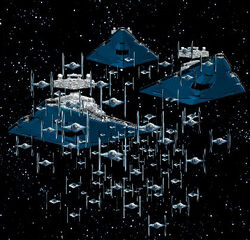
Part of the fleet.
Where all previous units were generally bound to specific system or set of systems, the Imperial Navy designated a fleet as a "sector resource", allowing it to operate on a sector-wide scale. A fleet was the smallest unit transferred between sectors. With such a large number of units, there were thousands of potential types of fleet alignments. Common fleet deployment types included superiority fleets, assault fleets, and bombard fleets. Other examples of alignments that a fleet might have taken included a deepdock fleet, support fleet, or ordinance fleet.
Superiority fleets maintained space superiority in sectors with "four or fewer world confirmed hostile to the New Order, and no more than 16 additional worlds with confirmed significant hostile elements", a superiority fleet was deployed. With six Imperial-class Star Destroyers and almost 400 other starships, a superiority fleet was presumed to be a sufficient force for relatively calm sectors.
Assault fleets transported huge numbers of Imperial Army and Navy troops to coordinate ground operations, while maintaining space superiority around the targeted systems. With two transport forces and two force escorts, an assault fleet engaged in massive planetary and system-wide ground campaigns.
Bombard fleets contained an average of 416 ships, allocated between two system bombards and two force escorts. Bombard fleets were assigned to sectors where the Empire had determined the probability of repressing the Rebellion in the sector to be less than even. System bombards were used when the Empire would rather completely destroy a world than see it fall into Rebel hands.
Notable fleets
Fleets within the Imperial Navy include the 15th Deep Core Reserve Fleet; the 27th Denarian Fleet; Admiral Kohrin's second fleet; Banjeer's fleet; the Black Fleet; the Byss Defense Fleet; the Centrality Navy; the Chandrila Defense Fleet; the Charis Fleet; the Coruscant Defense Fleet; Crimson Command; Death Squadron; Digit Squadron; DK-209 the Emperor's fleet; First Naval Fleet; Gandle Ott system defense force; the Grand Imperial Navy; the Ground Pounders; the Hammer Group; the Imperial Fourth Attack Squadron; the Imperial Outer Rim Territories Patrol Fleet; the Inner fleet; Lumiya's fleet; the Maw fleet; the Outer Rim Imperial Fleet; Qeimet fleet; the Secret armada; the Shadow Hand Fleet; the Solaest Fleet; the Swift Wing; Task Force Vengeance; Task Force Whirlwind; the Third Ado Superiority Fleet; Thrawn's fleet; the Torize planetary defense force; the Vengeance Battle Group; and the Western Reaches Superiority Force. In addition, there was also one Unidentified Imperial fleet and one task force.
Sector group
- "The Empire's standard Sector Group strength was only twenty-four Star Destroyers. They were able to exercise control over an entire system with a single Imperial-class ship. They were able to overwhelm anything up to a Class Four planetary defense with one-third of a Sector Group."
- ―Etahn A'baht.
A sector group was the sum total of Naval strength which the Empire expected to commit to a normal sector. A high admiral commanded a sector group, a title usually granted to the Moff who governed the sector. In sectors that were involved in constant and severe naval actions, the High Admiral was a separate position from the Moff. A sector group could be expected to contain at least 2,400 ships, 24 of which were Star Destroyers (Imperial-class Star Destroyers were the norm, but some groups contained older model Star Destroyers), and another 1,600 combat starships.
The sector groups included Azure Shield, assigned alongside the 1st Sector Army, Azure Hammer Command to the Azure Sector of the Imperial Center Oversector; the Baxel Sector Fleet, assigned to the Baxel sector; the Brak Sector Fleet, assigned to the Brak sector; the Braxant Sector Fleet, a fleet composed of 13 Imperial-class Star Destroyers assigned to the Braxant sector that included the Obliterator, Ironhand, Relentless, and the Tyrannic; the Candoras Sector Fleet, composed of four Dreadnought-class heavy cruisers and other smaller ships assigned to the Candoras sector; the Coruscant Sector Fleet, assigned to Coruscant due to it being a sector in itself; the Elrood Sector Fleet, assigned to the Elrood sector composed of the Imperial-class Star Destroyers Stalker and Thunderflare, the Bayonet-class light cruiser Rintonne's Flame, and smaller vessels, including 12 system patrol crafts, custom vessels, Skipray Blastboats, and various TIE fighters; the Kathol Sector Imperial Fleet, assigned to the Kathol sector; the Kuati Sector Forces, assigned to the defense of Kuat; the Oplovis Sector Fleet, assigned to the Oplovis sector; the Tapani Defense Force, assigned to the Tapani sector; the Tierfon Sector Fleet, assigned to the Tierfon sector; and the Trax Sector Group, assigned to the Trax sector.
Regional, oversector and strategic command
Regional, oversectorial and strategic military commands existed as well, and came in a variety of mixed[15] and homogeneous[16] forces.
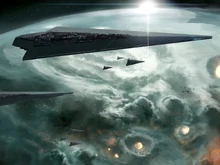
A fleet consisting of Executor-class Dreadnoughts, Imperial-class Destroyers and Nebulon-B frigates conduct an orbital bombardment
Black Sword Command was a regional command that defended the Core regions from threats emanating from the galactic rim. It had three Super Star Destroyers as part of its fleet assets.[17] Azure Hammer Command, based out of Anaxes, defended Sector Zero and consisted of 57 capital ships, led by the Super Star Destroyer Whelm.[18] Likewise, Crimson Dagger Command, also based out of Anaxes, defended the Quelii Oversector, and was instrumental in the Ciutric Offensive during the Reconquest of the Rim in the early stages of the Imperial Period. Cerulean Spear Command, likewise, was charged with the defense of the Maldrood Oversector, and was instrumental in the Sy Myrthian Insurrection during that same time period.[8] Additionally, a full ten percent of the entire Imperial Navy was kept in reserve in the Core Worlds, so as to be able to quickly respond to threats throughout the galaxy.[19] In the Outer Rim Territories, a fleet with at least 19 Imperial-class Star Destroyers and three Immobilizer 418 cruisers, the latter supplied by Imperial Drydock IV, was also kept.[20]
Roving fleets aimed at specific tasks were fielded at several points in Imperial history. Notable units included Death Squadron[6][21] and Scourge Squadron,[22] which hunted for Rebel bases in the Outer Rim. There was also the Vengeance Battle Group, used by the Dark Jedi Jerec to search for the Valley of the Jedi,[23] and the secret armada assembled by Admiral Mils Giel, for the purpose of transporting a vital biological device from the Outer Rim to Imperial Center.[15]
At least one Star Destroyer task force was used to punish Imperial sectors that threatened to undermine Imperial rule, as when the Moff of the Trans-Nebular sector established himself as the de facto warlord and was engaged by a fleet of Star Destroyers. This force was large enough to leave behind vessels that would form the core of a new sector fleet, before moving on to other trouble spots.[16] There was also a fleet stationed near Byss, that was formed since the start of the Galactic Empire. The Emperor himself also possessed a personal fleet that he has command over, utilizing it in situations important enough to require him to participate in person.
Infantry units
Although the main ships of the Imperial Navy were important, the manpower was also vitally important within the navy. This manpower came in the form of those who defended the vessels from external threats, either from directly within the vessels such as Imperial gunners, distinguishable by their thick, low-visibility helmets, or by flying fighter craft to engage these threats, such as TIE pilots and Cruisemissile troopers, the latter acting as the pilot of the Cruisemissile assault craft; those that manned the vessels to go where they needed to go, such as Imperial Navy crewmen, which directly monitored the various instruments on various vessels including the bridge and maintained the vessels. The crewmen were often placed in pits as an intimidatory measure. Other important assets include direct, on-foot fighting forces, such as Imperial Marines, a specialized branch within the Stormtrooper Corps identified by the orange shoulder patches on their right shoulders; Imperial Navy troopers, which were distinguishable by their helmets and black clothing; Imperial Navy commandos, which were elite forces within the Imperial Navy; and SpecNav Force troopers, short for Special Navy Force troopers, which, like the Imperial Navy commandos, were among the Navy's elite forces, and were also kept very secret in their existence. Occasionally, the Emperor's Royal Guard will sometimes participate in Imperial Navy formations.
Divisions and Departments
Besides the overall Navy, there were also several divisions within the Imperial Navy. One was the Imperial Navy Intelligence, which dealt with intelligence-gathering activities. Another was the Navy's secret elite force, known as the Special Navy Force. The Imperial Navy Research, Development and Engineering Center was responsible for developing new Imperial warships at least since prior to the Battle of Endor. The special forces carried out special operations for the Navy on foot.
The overall Navy itself also possessed four organizational arms: the Fleet Support Branch, the Line Branch, the Flight Branch, and the Support Service Branch. In addition, each of these organizational branches are divided into divisions that focus on specific areas in the Imperial Navy.
The Fleet Support Branch consisted of officers responsible for maintenance and engineering duties. Within this branch were two divisions: Engineering Division and Technical Services. The former focused on maintaining various Navy ships' sublight and hyperspace engines, as well as the integrity of the ships' hulls. The latter was responsible for looking after power distribution, life-support, and other specialities outside the Engineering Division's jurisdiction. Technical Services' equivalent in the Systems Force was called the Force Technical Services.
The Line Branch was tasked with handling strategy, tactics, and administration within the Naval forces. It housed various divisions, the three largest being the Deck Division, the Logistics Division, and the Administration Division.
The Flight Branch was tasked with overseeing the operations of combat starships. It had various smaller divisions as well as one large division known as the Flight Division. In addition, the Flight Branch held purview over the Navy Order of Battle.
The Support Service Branch provided services to allow Navy personnel to carry out their duties. It had at least five branches: Ordinance, Gunnery, Communications, Biological, and Astrogation. Ordinance dealt with the installation and maintenance of various naval ships' weapons systems. Gunnery supplied personnel to man the weapons systems. Communications controlled traffic and handled information systems. Biological handled research and providing medical services, and Astrogation calculated hyperspace routes alongside other navigation-related matters.
Starfighter Corps.
The Imperial Navy also was home to the Starfighter Corps., which was home to various TIE Fighter squadrons. Those who participated were often extremely skilled, as the flight schools were very dangerous.
Capital ship classes
Space stations and superweapons
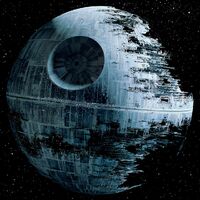
The Death Star II, one of the deadliest weapons developed by the Empire.
The Imperial Navy has its fair share of space stations and superweapons, as did the rest of the Empire. The various space stations it had filled a variety of purposes, and extended from completely artificial to being built on natural terrestrial space debris such as Asteroid bases. For instance, the Achtnak Turbine Station was created specifically as a means to secretly deploy various TIE-series fighters to enemy locations from within a Gas Giant. Similarly, Gravity Well Stations were frequently utilized to prevent enemy fleets from jumping into hyperspace. The Baas-class space station, Gateway Space Station, Resupply bases, and Cargo Facilities 1 and 2 were likewise acted as deep-space supply depots for the Imperial Navy and for other elements of the Galactic Empire.
Some space stations also acted as prison camps, with several even being considered heavily classified. The Bakura and Maw Imperial Prisons at the planet Bakura and the Maw Cluster, respectively, are notable examples of this, as were Crseih Station.
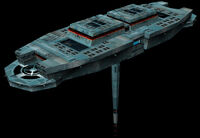
A Golan SpaceGun.
Various other Space Stations also were developed specifically for military operations, such as the Bavos-I heavy-duty military space platform and Bavos-II heavy-duty military space platform were some examples, alongside the Cardan-class space stations, of which five known classes, the Cardan I, Cardan II, the Cardan III, the Cardan IV, and Cardan V, which acted as defense stations for the various Imperial-related bases, including Kuat Drive Yards. The Golan-series space defense platforms, which included the Golan Space Defense SpaceGun, the Golan II Space Defense SpaceGun, and the Golan III Space Defense NovaGun, were orbital gun varieties. Kuat Drive Yards also had several weapons platforms to defend the shipyards. Some space stations/satellites were also developed specifically as defensive measures, such as the Imperial Shield Stations stationed at Fondor or the Satellite force field shield projectors at the Maw Cluster.
Some space stations also specialized in communication efforts, such as the Comm Center and the Communications satellite. The Communications satellites, however, had varying shapes, although all of them did possess black folds similar to TIEs. At least one was attempted to be used during the Battle of Yavin. The IOS 24, known as a Main Sensor Array, also acted as a radar system.
Dedicated Siege Platforms, although technically under the operation of Battle Station Command, were used specifically to commit sieges against various places. Examples of such space platforms included some types of Torpedo Spheres, including one model produced by the Loronar Corporation. The latter model also had at least 6 created and utilized by the Navy/Empire.

Jovan Station.
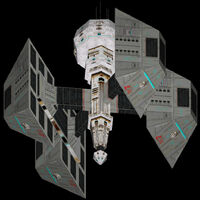
A X7 Factory.
Several were also utilized for creating or maintaining various ships of the Imperial Navy, such as the Naval Station Validusia in the Validusia system, the Deepdock R/M Facility Number Four, the TIE Fighter Construction Facility, Orbital Space Dock II, Orbital Space Dock III, and Orbital Space Dock IV-A, the Repair Yard, the TIE Staging Areas across the galaxy, the galaxy-shaped Jovan Station, the Deep Space Manufacturing Facilities (also known as X7 Factories), Drydocks such as Imperial Drydock IV, facilities and the Imperial Transfer Port at Kuat, the Type II Orbital Repair Yard, Telgorn shipyards, and the XQ Platform series of construction stations, which included models XQ1, XQ2, XQ3, XQ4, XQ5, and XQ6. These facilities, however, can also focus on developing parts for other Space Stations and especially superweapons, such as Desolation Station.
Some space stations were also meant to train various Imperial forces, such as Miramar. Others also focused on medical related matters, such as the Hale Return. In addition, some space stations acted as checkpoints for hyperspace paths, such as the Imperial Claw Station, or otherwise did research materials such as the Imperial research center. Some acted as shadowports for classified research, such as the Itani Nebula Base.
Some stations, however, had no apparent military-related reason other than civilian usage, such as the Golan-series space colonies, which included Space Colonies 1, 2, and 3, as well as the Habitation spheres, although it was rumored that the latter had some military related purpose. Another one was Junkyard Control, a space station that regulated the recycling of scrap, as well as the Derilyn Platform, although that one does have a Derilyn Space Defense Platform. In addition, the Orbital Solar Energy Transfer Satellites, which had been inherited to the Galactic Empire after it had been changed from the Galactic Republic, was used to shine the sun on Coruscant. Some stations were even originally benign yet were modified for military-related purposes, such as the Ionic Ring Ship.
The superweapons utilized by the Imperial Navy included the Sun Crusher, named such because its payload is more than capable of causing a supernova, as well as the Galaxy Gun, which could fire hyperspace-capable warheads capable of shattering an entire planet. The most infamous of these superweapons, however, were the Death Stars, battlestations that were capable of destroying a planet with a single blast from its superlaser. The Death Star Prototype acted as a test bed for its superlaser capabilities, with it being improved by the time of the Galactic Civil War to have a fully working model, the DS-1 Orbital Battle Station.[4] Two more were created, the Death Star II[10] and Death Star III near Endor, where their weapons systems were further improved, although unlike DS-1, they had never been fully completed prior to their destruction. The Habitation spheres of the Empire were also rumored to actually be Death Stars in development. Although technically not a Death Star, the Wilhuff Tarkin, based on a prototype Eclipse-class dreadnought hull system, had initially been nicknamed as such by the Rebel Alliance due to its similar properties. The Battlemoon was a type of superweapon that was built into a natural moon. During the time of the Dark Empire, World Devastators were also utilized by the Emperor to turn entire worlds into raw materials for creating new ships.
Probably the most insidious of these stations, however, were Worldcrafts, which were completely artificial worlds that on the surface seem completely natural. These were given to the Emperor's closest allies, and were hyperdrive capable.
Even after the Imperial Navy's influence dwindled upon it becoming the Imperial Remnant, it still had some degree of control over space stations, having a customs station at the Remnant world of Bastion.
Battleships and dreadnoughts
During the height of the Galactic Empire, the Imperial Navy had several battleships and dreadnoughts under its disposal, which in addition to possessing a tremendous amount of firepower, also acted as agents of psychological warfare under the Tarkin Doctrine. Although Star Dreadnoughts entered the full fray and became immensely popular during the Galactic Civil War, they had their roots in the early days of the Empire with a prototype vessel that was being constructed near Byss as part of the Sarlacc Project, although it had been destroyed before ever being completed.
The most famous of these was the Executor-class Star Dreadnought, which was among the largest vessels the galaxy has ever seen, even being the largest in terms of length. At least one variant existed that possessed cloaking capability. The most famous vessel among this class was the lead ship of Death Squadron and first vessel within the class, the Executor. Others included the Mandator-series Star Dreadnaught, which had three vessels developed, the Mandator I-class Star Dreadnaught, the Mandator II-class Star Dreadnaught, and the Mandator III-class dreadnought. Although the Mandator I and Mandator II-class dreadnaughts overall had very similar characteristics, the Mandator III-class was a significant change in the program, where it heavily focused on the weapons and raw firepower aspect of the design, even surpassing the length of the prior two Mandator models by 4,000 meters. The developmental cousin of the Mandator-series, the Bellator-class dreadnought, had a similar alteration in its design, being primarily focused on speed instead of power, being 800 meters shorter than the Mandator I and Mandator II-classes. Another Star Dreadnought was the Assertor-class Star Dreadnought, of which its most famous member was the Wrath, which had participated in a Base Delta Zero operation.
During the Galactic Civil War, to disguise the size of the then-in-development Executor-class, several design and budget reports were falsified to pass red tape and budgetary hearing committees, even adopting the name Super-class Star Destroyer, which acted as the partial namesake for the colloquialism Super Star Destroyer for any vessel larger than a Star Destroyer.

The Super Star Destroyer Vengeance with elements of the Vengeance Battle Group.
Another dreadnought variant was the Vengeance-class dreadnought, which had the same length as the Executor-class Star Dreadnoughts, but is significantly slimmer. A famous example of these ships was the Vengeance, the flagship of the rogue Imperial Inquisitor Jerec and his faction.
The Aurora was involved in a raid on Kuat Drive Yards by the New Republic, where it was infected with a virus and rendered inoperable. However, it was then destroyed by Imperial Agents by sending it into a sun via Hyperspace.
The Emperor also intended to create next-generation dreadnoughts, which included the Sovereign-class dreadnought line and the Eclipse-class dreadnought. Although all four Sovereign-class dreadnoughts ended up destroyed by the time the Emperor had been revived, the Eclipse-class, which included the Eclipse and the Eclipse II, saw use by the revived Emperor under his Dark Empire.
Besides the Star Dreadnoughts, there were also some that were incorporated from prior to the Galactic Empire by other factions, such as the Lucrehulk-class battleships. In addition, the Eye of Palpatine was classified as a dreadnought, and intended to deliver several stormtrooper units to subjugate a planet.
Even after the restructuring of the Imperial Navy after the formation of the Imperial Remnant, dreadnoughts and battleships still played some roles in their organization. In addition, another Star Dreadnought under the Imperial Remnant was the Megador, which possessed 16 thrusters.
Battlecruisers
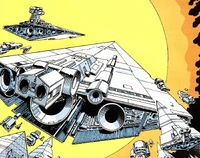
An Imperial armada led by the Helmsman, a Praetor Mark II-class battlecruiser.
Although the Imperial Navy had several battlecruisers within its various fleets, they were comparatively rarer compared to Star Destroyers or even Star Dreadnoughts, because they were both extremely expensive and they didn't even had the psychological warfare effect that Star Dreadnoughts have. Because of their being larger than Star Destroyers, and in part because of the falsified Super-class Star Destroyer line, battlecruisers were likewise sometimes called Super Star Destroyers.
Star Cruisers were on the lower end of the battlecruiser classification. The most well-known example of a Star Cruiser within the Imperial Navy was the Allegiance-class battlecruiser, which were also sometimes referred to as Imperial-class destroyers and Super Star Destroyers due to their visual resemblance to the Imperial-class Star Destroyers as well as their being larger than most Star Destroyers, respectively. The most famous ship in this class was the Allegiance.
The Praetor-series were also a well-known battlecruiser type within the Imperial Navy, with its classes including the Praetor-class battlecruiser, which was inherited from the Galactic Republic, and the Praetor II-class battlecruiser, which was well known for the flagship of the Secret armada, the Helmsman.
During a raid on Kuat Drive Yards, the Event Horizon, the Luminous, and the Stellar Halo had been rendered ineffective due to a virus uploaded by the New Republic during the battle. However, the Stellar Halo was then sent into hyperdrive into a sun as a final means of defiance by Imperial agents.
The Pride of Tarlandia was a Battlecruiser[8] that was part of Death Squadron, as well as the Executor's second-in-command vessel. It acted as the main communications ship, and possessed communication jamming abilities to further disorganize the enemy. This ship would eventually fall during the Battle of Endor. Another Battlecruiser, the Ilthmar's Fist, survived the battle.
Star Destroyers
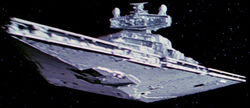
An Imperial I-class Star Destroyer, signature vessel of the Imperial Navy.
A Bellator-class dreadnought orbiting Byss in 10 ABY with a Procursator-class Star Destroyer escort.
Star Destroyers, named for their purported capacity of destroying entire star systems, were the most recognizable ship class within the Imperial Navy. Several of them, such as the Venator-class Star Destroyers, the Secutor-class Star Destroyers, the Victory-class Star Destroyers, the Tector-class Star Destroyers, and even the Imperial-class Star Destroyers had been holdovers from the Clone Wars. The Victory and Imperial-class Star Destroyers also had at least two variants. In the Victory-class's case, they were the Victory I-class Star Destroyer and the Victory II-class Star Destroyer. In the Imperial-class's case, they were the Imperial I-class Star Destroyers and the Imperial II-class Star Destroyers. Each variant had some improvements to their predecessors, such as the Imperial II-class carrying ion-cannons. The Imperial-class before the Galactic Empire had been known as the Imperator-class. At least one Imperial-class, the Shockwave, was extensively modified.
The Secutor-class Star Destroyer, under the size requirements of the Anaxes War College System, would technically qualify as a battlecruiser. However, the ship was lacking in the amount of weaponry required for such a class, and its carrier role had it act as a Star Destroyer. There were also some Corellian-engineered Star Destroyers in use by the Imperial Navy, which were purported to be very fast, even the fastest among the Imperial forces.
Some Star Destroyers also featured some aspects that were a combination between two different ship types. For example, the Interdictor-class Star Destroyer combined elements of the Imperial-class Star Destroyer and the Interdictor cruisers, most notably the gravity well generators seen on the latter. In addition, some Star Destroyers could also be modified outright: The Conqueror, for example, had a large portion of its hull cut out to make room for a superlaser dish.
Although most Star Destroyers followed the wedge-shape design utilized by Kuat Drive Yards, not all of them did. A notable exemption was the Gladiator-class Star Destroyer, which possessed an opening within the ship's bow that allowed for the ship to release several fighters. One of the most famous examples of the Gladiator-class was the Demolisher, the flagship of Admiral Screed.
There were also other types of Star Destroyers, such as those orbiting around the junkyard planet Nar Shaddaa.
Not all Star Destroyers acted as carriers, however: The Tector-class Star Destroyer, a heavily armored Star Destroyer class, notably lacked any docking bays.
The Sorannan-class Star Destroyers had also been utilized by the Black Sword Command, or Black Fleet. A notable member of this class was the Rakehell.
During the early days of the Galactic Empire, one Star Destroyer was outfitted with a superlaser, and was used during Operation: Twilight to destroy a Jedi Enclave on an asteroid. This destroyer bore a large resemblance to the Harrower-class dreadnoughts, which had been cited by Palpatine to have been the direct inspiration of many of his warships, including the Star Destroyers.
The Procursator-class Star Destroyer overall had similarities to the Imperial-class, but was significantly smaller.
Even after the Imperial Navy, as a result of the formation of the Imperial Remnant, was reorganized, it still retained the use of Star Destroyers, even developing new ones such as the Turbulent-class Star Destroyer.
Star Destroyers continued to see their way in the Navies of the Galactic Empire's successors, the Fel Empire and Darth Krayt's Galactic Empire. Both factions made use of the Pellaeon-class Star Destroyers, but the latter group utilized the Imperious-class Star Destroyers.
Destroyers and cruisers

A Dreadnaught-class heavy cruiser, representative of a durable class that spanned centuries and governments.
The Imperial Navy also had at its disposal various non-Star Destroyer-type destroyers and cruisers. The Vindicator-class heavy cruisers were even used to guard areas that Star Destroyers were unavailable and needed required firepower to hold off enemies.
One of the earliest cruisers in use by the Imperial Navy was the Bayonet-class light cruiser, as well as the Carrack-class light cruiser, the latter acting an important role due to its relatively heavily armed status as well as it being able to combat X-wing starfighters. The Detainer CC-2200 interdictor cruisers were likewise involved with the Imperial Navy as early as its formation in 19 BBY. One of the more ancient vessels, the Dreadnaught-class heavy cruiser, was also involved in the Imperial Navy. The Invincible-class Dreadnaught Heavy Cruiser, likewise, saw usage even though it was ancient. The Tartan-class patrol cruiser was also one of the earliest cruisers developed by the Galactic Empire for the Imperial Navy.
Other vessels are also used, although not nearly to the same extent due to various reasons, and thus are placed in areas that required minimal priorities. One example was the Munifex-class light cruiser, which had originally been utilized in the Trade Defense Forces, with its low-power hyperdrive making it a hassle in constant combat.
One of the more valuable vessels of these classes was the Immobilizer 418 cruiser, which possessed gravity well generators to prevent enemy ships from escaping into hyperspace. The Enforcer-class picket cruiser was likewise capable of generating even more power to the gravity well generators than the 418 thanks to some modifications when undergoing development.
Some cruisers and destroyers were not meant to be involved in direct military operations. Such vessels included the ISS Empirical, which was a research vessel owned by Darth Vader, as well as the Imperial Research Ship, which had been involved in the experimental TIE program.
Although most of the destroyers and cruisers weren't developed in accordance to the Tarkin Doctrine, one was, the Dragon-class heavy cruiser, which was deliberately developed to resemble a dragon to inspire fear to the various planetary population. Only one ship of this class was known to have existed, the Galaxy Dragon, a ship owned by Moff Derluin.
Some were also designed to monitor vessels, such as the KDY light cruiser. However, its systems could not intercept vessels of a certain speed.
The Imperial Navy also made use of light cruisers, such as the Bayonet-class, the Carrack-class, and the Pursuit-class; medium cruisers including the Strike-class medium cruisers, also known as the Imperial Strike Cruiser, which included the Moffship and the Eidolon; and bulk cruisers, including the Neutron Star-class bulk cruiser.
Many high-ranking imperials also utilized various cruisers that were even modified. The Imperial High Inquisitor Mox Slosin utilized a modified version of the Trenchant-class cruiser, called the Ironhand
Assault cruisers also became involved during the New Republic era, including the Vibre-class assault cruiser.
During the Black Fleet Crisis, the Adz-class patrol destroyer was a recent development within the Imperial Fleet, and was likewise used by Black Sword Command, or Black Fleet.
Even when the Imperial Navy was reorganized after the Empire turned into the Imperial Remnant, destroyers still saw some use, even developing a new vessel, the Republic-class cruiser for use against the Yuuzhan Vong.
Carriers and assault ships

An escort carrier.
The Imperial Navy also had access to various carriers and assault ships. The Acclamator-series assault ship, encompassing the Acclamator I-class and the Acclamator II-class, had earlier been utilized during the Clone Wars, and were involved fairly early in the Imperial Navy's formation. The Liftwing carrier was also present among the Imperial Navy since possibly even long before the Clone Wars.
Various Star Destroyers, such as the Gladiator-class, the Venator-class and the Secutor-class, also had carrier roles.
There were also instances of them being used for boarding purposes, such as the Spiral-class assault ship, although they usually only had one use.
One capital ship also had features of both the Gladiator-class Star Destroyer (in particular the bow's forward docking bay) and the Praetor II-class battlecruiser. This ship also ended up being used by Admiral Giel for his secret armada.
Escort Carriers were also prevalent among the Navy, of which two known models were utilized: one model for the regular Imperial Navy, and one for the exclusive use of the Imperial Storm Commandos. However, even the standard Escort Carriers weren't frequently utilized by the Imperial Navy.
Carrier and assault ship types still saw some usage among the Imperial Navy, even after it was reorganized into the Imperial Remnant. One example was the Doomgiver, although the ship class the Doomgiver belonged to might have been utilized during the height of the Galactic Empire.
Frigates
The Imperial Navy also utilized several frigates. The Corellian-designed DP20 frigate was a well known asset to the Imperial Navy. They also had access to the EF76 Nebulon-B escort frigate and Nebulon-B2 frigate, although many of the former class of frigates eventually ended up in the Rebel Alliance's hands, which led to some grief from one of the Navy's admirals, Hurkk. A variant of this class, the Imperial Patrol Frigate, was eventually created after Palpatine's death at Endor. Similarly, the less-shielded Interceptor-class frigate was often hijacked from the Navy for use by pirate organizations.
The frigates were versatile and could be used for a number of actions. The Lancer-class frigate was primarily utilized by the Navy for anti-starfighter operations, while the Clone Wars-era MedStar-class frigate was for medical purposes. The Pelta-class frigate likewise acted as both a cargo and a medical frigate. The Star Galleon-class frigate also acted as armed escorts for other vessels of lesser firepower.
Some frigates are capable of carrying fighters to battle, such as the Imperial cutter. In addition, some frigates could also hold the same name as some Star Destroyers, such as the Imperial II-class and Victory II-class frigates. Zebulon-B frigates were also utilized by the Navy, and were less powerful than the Lancer-class.
The Galactic Empire's successors, and by extension, the successors of the Imperial Navy, the Fel Empire and Darth Krayt's Sith Empire, later used the Ardent-class fast frigate.
Corvettes and gunships
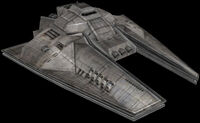
A Broadside-class cruiser kdb-1, an Imperial missile corvette.
The Imperial Navy also utilized various gunships and corvettes. Many of them, including the Assassin-class, DP20, CR70, and CR90 corvettes, were of Corellian design. Others, such as the Marauder-class corvette, had its origins in the Clone Wars. The Vigil-class corvette also was utilized by the Imperial Navy, including near space stations such as Naval Station Validusia.
Although primarily for military work, such as the Sienar-developed Lianna-class corvette and the Broadside-class cruiser kdb-1, some corvettes, such as the Guardian-class light cruiser and the Light corvette, were assigned to security detail. The Warden-class light cruiser, likewise, was developed as a followup to the Guardian-class. The Ye-4 gunship acted as the Imperial Navy's primary gunship.
Corvettes still saw use even after the Imperial Navy was reorganized into the Imperial Remnant, with two new classes of corvettes, the Crusader-class and the Cutlass-class, being developed during that time.
Patrol ships
The Imperial Navy also, albeit to a far lesser extent than the other vessels, utilized patrol ships.
One known vessel of this classification was the Fast-attack patrol ship. Although not used by the Imperial Navy directly, they were affiliated with them as the Nohgri Death Commandos were allied to the Imperial Navy and under their command.
Prototype designs
The Imperial Navy also had some unused designs for their fleet, for various reasons. The Imperial Navy planned on developing a new type of Star Destroyer, even creating a prototype but the plans ended up stolen by the space pirate Tyber Zann and his crime syndicate, the Zann Consortium in the confusion caused by the destruction of the Death Star over Yavin, with his stealing the prototype vessel shortly thereafter, forcing the Imperial Navy to discontinue the project. This destroyer would later come to be known as the Aggressor-class Star Destroyer, a mainstay of the Zann Consortium. Earlier, there were also plans to create an Imperial ship that incorporated Calamarian technology, but it was labelled a failure and the project ended up cancelled because it was incompatable with human technology. Wilhuff Tarkin, a fan of Mon Calamari style architecture, had spearheaded the project.[source?]
Starfighters
Just like any navy in various points in Galactic History, the Imperial Navy had access to various starfighter craft to either attack enemies or to defend the fleet.
Multi-purpose
Various fighters were utilized for multiple purposes during the time of the Imperial Navy's formation, some either being created during the Empire or otherwise were holdovers from the Clone Wars.
Among the first Imperial-developed fighters were the A-7 Hunter interceptors, a model of the A-Series interceptor line of superiority fighters which had been in use decades before the Clone Wars, and would continue to see service until the Second Galactic Civil War. They were initially well-received, with several Imperial officers even ordering them by the dozens for their vessels. However, they ended up replaced by the time the TIE-line came in. In addition, they also possessed several fighters from the Clone Wars, such as the Aggressive ReConnaissance-170 starfighters, Eta-2 Actis-class light interceptors, V-19 Torrent starfighters, Z-95 Headhunters, and Alpha-3 Nimbus-class V-wing starfighters utilized by the Galactic Republic, and the Belbullab-22 starfighters utilized by the Confederacy of Independent Systems, specifically by General Grievous. Some of these fighters, however, were often only used by elite members of the Imperial Navy. Because of the Emperor's homeworld being that of Naboo, N-1 Starfighters were also utilized during the early days of the Empire. The Toscan 8-Q starfighter was also utilized during the early days of the Imperial Navy,[24] although they were virtually obsolete by the time of the Galactic Civil War.
During the Galactic Civil War, various other starfighters were utilized, including the Alpha-class Xg-1 Star Wing, the I-7 Howlrunner, the INT-4 Interceptor, and the GAT-12 Skipray Blastboat. In addition, the A-9 Vigilance interceptor also was utilized against the New Republic.

A TIE shuttle, Missile Boat and TIE Scout
The most famous of the Imperial Navy's starfighters, however, were the TIE series. They included the TIE/LN starfighter,[9] the most common TIE fighter used during the Galactic Civil War; the TIE/IN interceptor, an interceptor-based model meant to improve on the TIE series when the TIE fighters were shown to have performed horribly against the Lightspeed Panthers; The TIE Aggressor; a combination between a fighter and a bomber that was rare to be found beyond the experimental phase; the TIE Advanced X1,[9] a prototype next-generation starfighter with hyperdrive developed by Darth Vader that, ironically, was cancelled in part because the Navy feared it would end up replaced; the TIE/ad starfighter, also known as the TIE Avenger, which was one of the few "Advance X" models to be accepted into the Navy; the TIE/D Defender, a new-generation attack craft designed to hold its own in combat, including effective shielding and a hyperdrive; the TIE Hunter, a TIE fighter operated exclusively by Storm Commandos that was designed to counter the Rebel's X-wing starfighter; the TIE/rpt starfighter, also known as the TIE Raptor, developed by Zsinj for exclusive use for his faction of the Empire, the Super TIE/LN starfighter, an improvement upon the original TIE/LN; the TIE starfighter, the first mass-produced product of the TIE series created by the Galactic Empire; and a TIE variant that shot boarding torpedoes. Although generally colored gray, the hulls can sometimes be colored red. These versions, particularly the TIE/IN interceptor line, are notably used by Emperor's Royal Guards, and are likewise referred to as the Emperor's Royal Guard TIE/In starfighter. Even rarer than the standard Advanced x1s were modified versions of the craft that were rumored to have been implemented by Vader himself. The TIE Light Duty rarely gets into mandatory missions and are usually used as training vehicles.
Even after its reorganization into the Imperial Remnant, the Imperial Navy still utilized several starfighters, including the Preybird-class starfighter. In addition, both of the Empire's successors, the Fel Empire and Darth Krayt's Galactic Empire, utilized the Predator-class fighter and the Fury-class starfighter.
Scout vessels
The Imperial Navy also had several scout vessels for intelligence gathering and reconnaissance. Battlefield Subjugation Floaties are a type of reconnaissance manned drone that could be used to investigate and even grasp objects of interest for the Empire. In addition, the Far Reach IV PQR was also frequently used by the Imperial Navy via the Survey Corps to scout out reconnaissance. In cases such as the Out System Scout Vessel, it was also used to scout out new worlds. Imperial sentry ships were also utilized to scan for any immediate threats during transport, such as any threats to Giel's secret armada. The Imperial Navy also utilized IR-3F Patrol Crafts and later IPV-1 System Patrol Crafts to monitor areas rife with piracy and smuggling. IPV/4 patrol ships were also utilized by the Imperial Navy.
In addition, ISP-6 Imperial Shuttle Pods were often deployed from much larger shuttle craft. Something similar existed with the SkyBlind reconnaissance ship for planetary exploration and reconnaissance. They could also deploy droids to scan areas for enemy activity via specialized pods, such as the Predator I Probe-Mate jump pods used to drop Viper probe droids to scan for Rebel activity in the Elrood system.
The Imperial Navy also owned the LightStealth-18 Reconnaissance Ship which was capable of silent running. They also had long-range scout shuttles such as the Mu-class Model 1 shuttle. The Empire's scout of choice, however, was the MRX-BR Pacifier. They were also known to have tens of thousands of PB-950 patrol boats, even when the line itself was discontinued after the Clone Wars. In addition, one of the roles of the VT-49 Decimator was reconnaissance, and could also picket ships among Imperial fleets, with its versatility making it one of the most feared vessels in the Imperial Navy.
The TIE series also had some fighters designed specifically for scout work. The TIE/fc starfighter, for example, while overall resembling a TIE/LN, was actually intended to scan for enemy bases to transmit back to the Imperial Navy. The TIE/rc starfighter had a similar design and purpose as the TIE/fc, although it instead targeted fleets and starfighter wings for reconnaissance. The TIE Vanguard was an upgraded version of the latter TIE fighter. Lastly, the TIE/sr starfighter, or TIE Scout, was a limited production TIE-series fighter that was intended to scout out enemies via advanced reconnaissance equipment, and was one of the few fighters of the TIE series to be equipped with a hyperdrive.
Some scout ships utilized by the Imperial Navy were civilian in nature, such as the Lone Scout-A.
During the events of the Dark Empire, the Imperial Navy also utilized long range intercept starships called Imperial Hunters.
Stealth
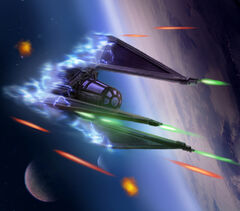
A TIE Phantom.
The only known attempt for stealth fighters were the TIE Phantom, which was developed with a built-in cloaking device. Although they saw usage, their development ended up terminated after the Rebel Alliance destroyed a significant portion of the TIE Phantom production facility, and the sole remaining prototype self-destructed before they could retrieve any data on it.
Droid
Although not as plentiful as manned starfighters or regular fighters, the Imperial Navy does make use of various unmanned starfighters, or droid models.
Missile droid were tripod unmanned fighters that could unleash a barrage of missiles at its enemies. They were most famously stationed at Dubrillion, where they guarded a superlaser testbed during the Battle of Dubrillion.
During Grand Admiral Thrawn's reign of the Empire, the Imperial Navy utilized several TIE/D automated starfighters which were run by a droid brain. They were fierce in battle.
During the Dark Empire, Palpatine utilized degrees of Sith alchemy to create biomechanical constructs called Shadow Droids that could be used to participate in starfighter battles. They were manned with organic brain-like cores.
Bombers
Bombers were also utilized by the Imperial Navy to flush out enemies or otherwise total enemy bases/ships.
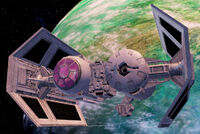
One of the more famous bombers within the Imperial Navy was the TIE/sa bomber, which carried a secondary hull that could be used to launch two general purpose warheads, although people using it as a secondary transport was another unplanned factor. It was the successor of the TIE/gt starfighter, which served a dual starfighter-bomber role. In addition, the TIE/sa bomber also had further improvements by adding more launcher hulls: Adding in an additional launcher hull created the TIE Heavy Bomber, while adding an additional pair to the left of the TIE's cockpit module created the TIE Interdictor. Besides the TIE/sa bomber and its various relatives, the Imperial Navy also had the Scimitar assault bomber and the TIE Oppressor, the latter of which was meant to be a light bomber, but had poor performance due to it using an earlier TIE engine that was incompatable with its needs.
Bombers also were utilized by the successors to the Galactic Empire, and thus to the Imperial Navy. The Sith-Imperial attack ship was utilized exclusively by Darth Krayt's Sith Empire, while the Neutralizer-class bomber was utilized both Krayt's empire and the Fel Empire.
Experimental
Some TIEs were also developed under the TIE Experimental Project. They were listed by M and a number between 1 and 5.
The TIE Experimental M1, codenamed the TIE Bizzaro, was a TIE variant with two pods, one at the starboard and one at the port, connected by a single TIE wing. The starboard pod was where the main controls were, and the port pod contained a cannon. Despite its odd design, it was slightly faster than the TIE/LN, and could also utilize a hyperdrive, although it was slaved and required a control ship to gain permission.
The TIE Experimental M2, codenamed the TIE BigGun, was similar overall to the TIE/LN, but had its chin-mounted cannons removed, and its wings equipped with turbolaser turrets.
The TIE Experimental M3, codenamed the TIE Warhead, was similar overall to the TIE/IN, but had its standard cannons removed, with its wings being equipped with warhead launchers.
The TIE Experimental M4, codenamed the TIE Bomb, was not actually a fighter or manned. Instead, it was a cruise missile modelled after the TIE series, and was packed with enough explosives to have five times the kamikaze destructive power of the TIE/LN.
The TIE Experimental M5, codenamed the TIE Booster, was a fighter that overall resembled the TIE/LN, but had a massive booster engine attached to the aft of the vessel, ensuring it had a lot of speed output.
Although they saw some usage, they were discontinued after the Rebel Alliance destroyed the main research platform for the TIE Experimental Project, the space platform Obsidian.
Prototype designs
The Imperial Navy also had some designs for starfighters that were either cancelled before implementation, served as a test bed only, was deliberately destroyed to prevent the enemy from using it, or otherwise were left unknown regarding their developmental status.
During the early days of the Galactic Empire, due to Palpatine's warmongering ways, the Imperial Navy had developed some prototypes for new starfighters. However, several of them, according to then-graduate Laurita Tohm, had bugs in the system regarding the ejection seat and controls resulting in it being unpredictable: Sometimes, it will eject without problems, but other times the fighter will end up self destructing accidentally when commanded to eject, incinerating the pilot in the process, or otherwise smash the occupant through the roof due to the ejection door failing to open.
The Rebel Alliance's T-65 X-wing starfighters had originally been developed for Imperial use. However, the engineering team responsible for developing the fighters ended up defecting to the Rebels, and also took the plans and prototype with them, preventing the Empire from seeing a use for them.
The TIE Phantom prototype, after the rest of the TIE Phantoms were destroyed by the Rebel Alliance, had been stolen by the Alliance. However, a self-destruct protocol was armed in case someone stole it and tried to access its data, ensuring that the Rebels could not gain any secrets.
The TIE Sentinel was seen in a painting, the Emperor's Eyes, during the Galactic Civil War, although its developmental status is unknown.
Support ships
Like any Naval organization throughout the history of the galaxy, the Imperial Navy also had several support ships at its disposal.
Logistics vessels
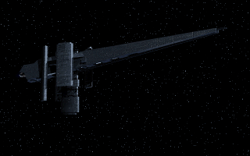
Arc Hammer factory ship.
The Imperial Navy had various logistics vessels for transporting supplies and necessary goods. The Altor-class replenishment ships were refuelling stations often accompanying a fleet, and were capable of refuelling both an Allegiance-class battlecruiser and an Assertor-class Star Dreadnought at the same time. The Combat utility vehicle likewise could reload and refuel starfighters or gunships. Carillion-class starships were also utilized as logistics sometimes.
An Altor-class replenishment ship refueling an Allegiance-class battlecruiser and a Assertor-class Star Dreadnought.
The Class-7 Repair Vessel was also used for repairing and supplying logistics to mining companies. In addition, the logistics covered a wide area of fields, such as communications, handled by the Imperial communications ship and Tech 4 Plexus Droid Vessels; customs and courier-related duties such as the Harbinger courier ship, the Star Courier and the Imperial Customs Frigate; Medical-related duties such as the Medstar-class frigate; factory and repair work such as Factory ships, which included the Arc Hammer, and the Mobile repair base; and prisoner transports such as the Imperial Leviathan and the Modular Taskforce Cruisers. In addition, logistics vessels also supply air support at times, such as the Star Cruiser. The ISB is sometimes involved in logistics for the Imperial Navy and other Imperial Military factions, even supplying Operations Vessels for the occasion. Trenchant-class cruisers also played some role in logistics.
They could also transport various people, even dignitaries, via logistics vessels, such as the C-3 passenger liner.
In 0 BBY, the Death star also had several complement craft that were stationed near the battlestation, namely to refill the station's supplies.
The Modular Taskforce Cruisers were also utilized most frequently under the Dark Empire. Worldcraft also sometimes acted as logistic vessels.
Freighters and transports
The Imperial Navy also had access to several freighters and transport craft. Many of them did not possess weaponry, but some did, such as the Imperial Patrol Ship, a militarized version of the Action IV transport. They also made use of the Action VI transports, and utilized various bulk freighters such as the BFF-1 and the Class VI. It also utilized several Container transports. The Imperial transports/freighters served a multitude of purposes, such as fuel transports via the Imperial tankers, cargo transports via the Imperial cargo ships, heavily armored transports via the Imperial Armored Transports, and regular transports via the Imperial transports.
A specialized transport used for carrying taxed Imperial credits from various planets to the sector capitol was called an Imperial treasure ship.
Besides transporting things within the vessels, various freighters and transports in the Imperial Navy also utilized several external means of transportation, such as the CT-11 space tug, the Hauler-2 cargo tug, the Utility Tugs and the Heavy Lifter.
The Imperial Navy also made use of prison transport ships, such as the Imperial prison barge as well as the Purgatory-class prison ship, and the various dungeon ships like the Kiltirin-class and Lictor-class dungeon ships.
Some freighters and transports, however, had a far more insidious purpose, such as the Imperial extermination ships, as well as several massive Imperial freighters that drained the planet of Gholondreine-β of its entire water supply as both punishment and an example of the Empire's power.
The Imperial Navy also had transports and freighters constantly stationed at their various battle stations, such as the various complementary craft around the Death Star, and the various cargo vessels and support transports near the Tarkin.
Although the Imperial Navy was not known to use the YT-1300 light freighter, it did once create a near-exact replica of the Millennium Falcon, the ship of Rebel mercenary and later General Han Solo as part of a trap.
The Field Secured Container Vessel was a multi-part vessel that could transport multiple spherical items across the Galaxy for the Empire to use.
The GR-75 medium transports were also utilized by the Imperial Navy, as were various other transports such as the YT-2400 light freighter, the Xiytiar-class transport, the Omega-class freighters, the Star Galleon-class frigatees, the Guardian-class patrol ships, Evakmar-KDY transports, and the Mobquet medium transports. StarTrains were also utilized for transportation.
Dropships and landing craft

The Imperial Navy also possessed several landing craft, dropships and boarding craft for various direct military operations. The Acclamator-class transport drop ships, modelled after the Clone Wars Acclamator-class assault ships, delivered troops directly to the field of combat. Several Clone Wars-era vessels were also utilized, such as the CR25 trooper carrier and the Low Altitude Assault Transport/infantry.
During the early stages of the Galactic Civil War, Boarding torpedoes were utilized, where they were shot out of a TIE variant to send various personnel into a craft. Similar boarding vessels, called Imperial Boarding Pods and Imperial Drill Pod Boarding Craft, were frequently shot out of Star Destroyers with several Stormtrooper attachments, most notably being used during the Battle of Kamino during the Galactic Civil War. They can also send some via hyperspace, such as the Dark Trooper hyperspace capsule.
Dropships were also utilized during various operations, notable examples being the Imperial dropship, the Imperial Dropship Transport, Imperial Troop Drop Pods, the F7 drop ships used by Grand Admiral Thrawn, the MT/191 drop-ships, the Warlord Dropships, Y-85 Titan dropships, and the Imperial launches. The IF-120 landing craft were also utilized, as well.
Sentinel-class landing craft were also utilized to deliver troops to the ground. However, they sometimes were modified into Imperial loader shuttles to drop large containers onto the battlefield.
Some transports also had a degree of weaponry onboard, making them attack or assault transports, such as the M-class Imperial Attack Transports, the LAAT/i and its variants, and the Multi Altitude Assault Transports.
Some vessels also deliver military hardware instead of soldiers, such as the Theta-class AT-AT barge, which delivers All Terrain Armored Transports. The TIE series also has a transport variant known as the TIE lander.
Even after the restructuring of the Imperial Navy under the Galactic Empire's change to the Imperial Remnant, landing craft and dropships still saw some use, such as the All Terrain Rapid Deployment Pod.
Utility and troop shuttles
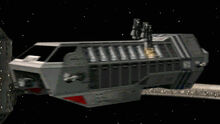
Spacetroopers disembarking from a Gamma-class assault shuttle.
The Imperial Navy utilized several Utility and troop shuttles in their operations, which were designed specifically for troops and small arms utility.
The Assault transports were often deployed to send troops to occupy a planet. The Gamma-class assault shuttles, Multi Altitude Assault Transports, and Gamma-class ATR-6 assault transports had similar purposes.
The Delta-class DX-9 stormtrooper transports transported stormtroopers to the field.
They also made use of shuttles. Some were used to transport high-ranking officers, such as the Imperial state ships, the Clone Wars-era Theta-class T-2c shuttles, and the Lambda-class T-4a shuttles. Others, such as the Delta-class shuttles, the Curich-class shuttles, the Grek-class troop shuttles, and the Mu-series shuttles, including the Mu-class Model 1 shuttles, the Mu-class Model 2 shuttles, and the Mu-class Model 3 shuttles, the Peth-class shuttles, Sigma-class shuttles, and the Tribune-class shuttles transported regular troops. Gamma-class Light Personnel Carriers were also utilized as well.
Escort transports were also utilized, such as the Beta-class ETR-3 escort transport and the Delta-class JV-7 escort shuttle. The CX-5011 PeopleMover was also frequently used, as was the Galleon.
The TIE series came up with two boarding shuttles, the TIE boarding craft and the TIE/sh shuttle.
There were also Imperial-class shuttles, such as the Svelte-class.
Long range shuttles were also in use, such as the Zeta-class long-range shuttle
Immediately prior to the Galactic Civil War, the secret apprentice to Vader as well as the de-facto founder of the Rebel Alliance, Starkiller, real name Galen Marek, utilized the stealth transport known as the Rogue Shadow.
The successors of the Galactic Empire, and by extension, the Imperial Navy, also utilized shuttlecraft, with the Sigma-class long-range shuttles being utilized exclusively by the Fel Empire and the Nune-class Imperial shuttle being utilized by both the Fel Empire and Darth Krayt's Galactic Empire.
Other
There were other ships that were involved to some extent with the Imperial Navy, but either had an unconfirmed classification or otherwise was not directly part of the Imperial Navy.
The Speizoc-g2000-equipped Carillion-class starships were involved to some extent with the Imperial Navy. Similar,y the Thran-class vessels were assigned to the Imperial Navy shortly after the Battle of Yavin.
The ISB Operations Ship, belonging to the Imperial Security Bureau, was not actually part of the Imperial Navy, as it was a separate organization. However, it has sometimes been assigned to the Naval Forces.
The Aramadia of the Black Sword Command Sector Army, or Black Fleet, was labelled as a Super Star Destroyer, although it was not specified whether it was of the Star Dreadnought class or the battlecruiser class. Similarly, another Super Star Destroyer was also among the Black Sword Command Sector Army, although it was never specified whether it was of the Star Dreadnought class or the battlecruiser class.
Martial theme
During its height, the Imperial Navy had a martial theme that it played in various actions, including graduation ceremonies for newly inducted cadets to the Navy.[25]
Behind the scenes
Starship classifications
It should be noted that considering the nomenclature of ship classification used by real life navies, some Star Wars starships appeared to be misnamed. However, it is to be expected that different cultures and societies go by internally rationalized classification-systems.
The Empire used different scales to classify their vessels. One of which culminated with Star Destroyers and Super Star Destroyers lumped into a sub-category of cruisers, and another which treated Star Destroyers as destroyers and further divided Super Star Destroyers into Star Cruisers, battlecruisers and Star Dreadnoughts. The former system was more often referenced, as many of the threats against the Empire were on a level that required little more than one Star Destroyer or a flotilla of them.
The Essential Guide to Warfare, which came out in 2012, attempted to address some inconsistencies in warship classification with its Anaxes War College System.
Appearances
Non-canon appearances
- LEGO Star Wars: The Video Game
- LEGO Star Wars: The Complete Saga'
- Star Wars: Visions of the Blade
- LEGO Star Wars II: The Original Trilogy
- "The Hidden" — Star Wars Tales 6

